趣味で覚える英単語 #12 相撲
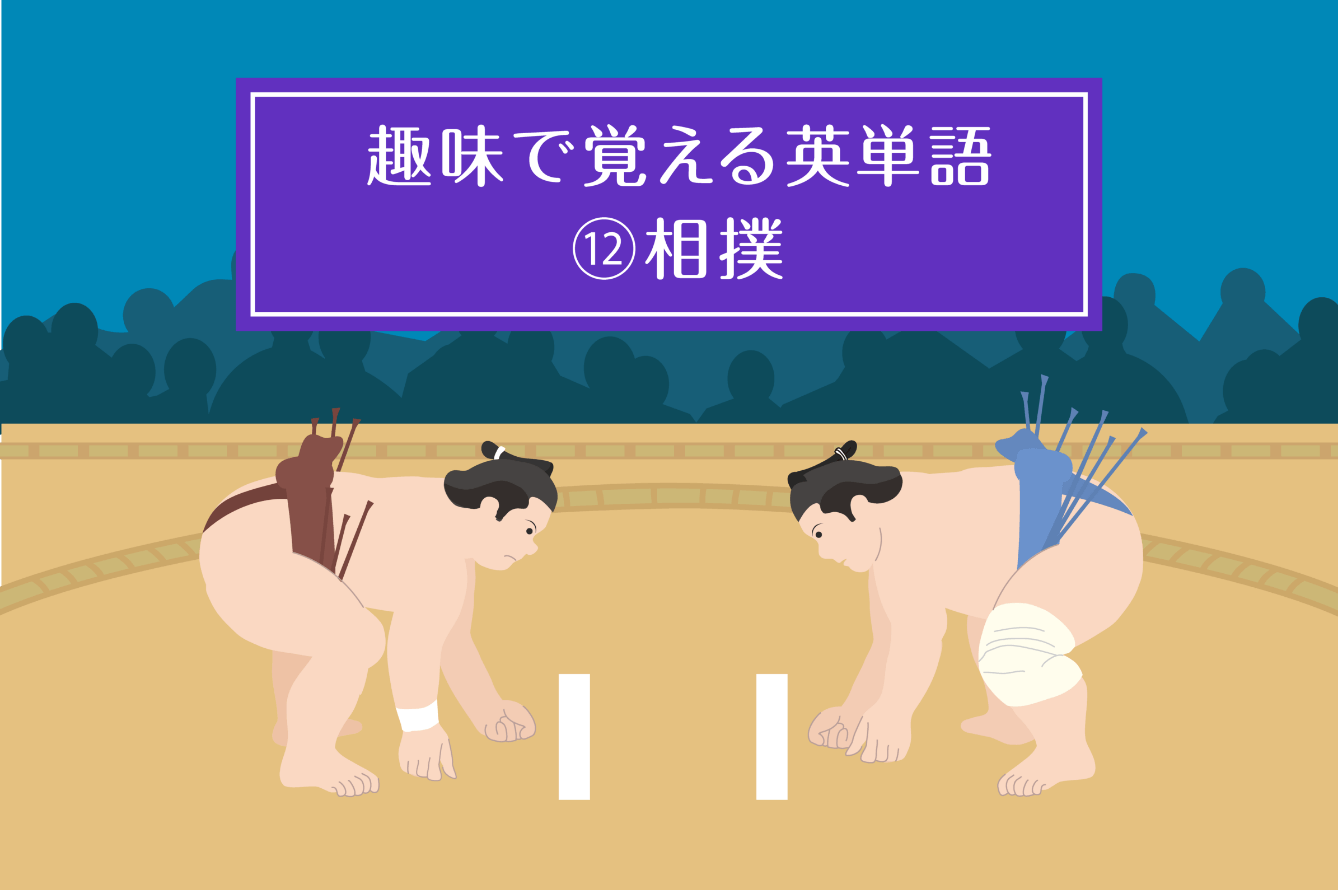
趣味の世界に国境なし! ブログやSNSなどを見ていると、同じ趣味を持つ他の国の人が英語で発信しているのを見かけますよね。関連する英単語を知っていると、そんな情報がぐっと楽しみやすくなります。
この「趣味で覚える英単語」シリーズは、毎回1つのトピックを取りあげ、それに関わる英単語を紹介していく記事です。今回のテーマは相撲です。日本の伝統文化のひとつである相撲は、外国人にアピール力があるコンテンツです。ルールがシンプルで勝負が短時間で決まる点も、「動画をちょっと見せて日本文化の紹介をする」のにむいています。しかしながら、日本語をそのままローマ字で表記する単語・表現も多く、英語で言い表そうとすると意外に大変です。この記事では、もとの意味が英語でうまく伝えられるような表現をまとめました。ぜひ参考にしてください!
※本記事の音声は、ネイティブスピーカーではなく自動生成機能を利用して作成しています。
※2022年2月現在、コロナ対策のため、観戦中の飲食禁止などの措置が取られています。本記事は通常時の営業形態にもとづき記述しています。
目次
相撲に関する用語

以下では、相撲の基本的な用語を挙げています。日本語でも独特の単語が多いので、英訳する場合は他の格闘技用語で代用したり、日本語のローマ字表記とそれに該当する英単語をハイフンでつないで言い表したりするとよいでしょう。このコラムシリーズでは通常、外来語はイタリックで表記しますが、この記事では省略しています。
基本用語
- 相撲:sumo /sumo-wrestling
(例)相撲は日本の格闘技のひとつで、今日でも神道の儀式の要素を含むスポーツです。:Sumo is one of the Japanese martial arts, and even today the sport includes ritual elements from Shinto. - 国技:national sport(s)
- 国技館:the Kokugikan Sumo Arena
- 大相撲:Grand sumo tournament
- 土俵:ring
- まわし:mawashi-loincloth /mawashi-sash /mawashi-belt
- 化粧まわし:ornamental apron
(例):土俵入りのとき力士たちはまわしの上に化粧まわしを着用します。それは伝統刺繍の芸術品です。:For the ring-entering ceremony, wrestlers add their own ornamental apron to their mawashi-loincloth, which is a work of art by traditional embroidery. - まげ:topknot
- 断髪式:topknot-cutting ceremony /retirement ceremony for a sumo wrestler
- 場所:tournament
- 本場所:annual tournament /regular tournament
- 巡業:tour
- 地方巡業:provincial tour
- 相撲部屋:sumo stable
- (行司がもつ)軍配:referee’s fan
(例)行司が軍配を返しました。時間いっぱいです。:The referee turned his referee’s fan around. Time is up. - 溜席(たまりせき)、砂かぶり席:Tamari-seki
(例)溜席は土俵から最も近い席です。力士が飛び込んでくることがあるので、危険なこともあります。:Tamari-seki are the closest seats to the ring. It’s sometimes dangerous to sit in them because wrestlers may happen to be driven into the space. - 桝席:Masu-seki /one box seating for four people
(例)桝席と溜席では、観客は床に置かれた座布団の上に座ります。:Spectators sit on zabuton, or Japanese cushion, which are set on the floor in Masu-seki and Tamari-seki. - イス席:arena seat
力士や番付、関係者に関する用語
- 力士:sumo wrestler
- 対戦相手:opponent
番付:rank
※[ ]内のように、日本語の用語をそのままローマ字表記するケースも多く見られます。
幕内:the highest division / the top division[Makuuchi division/ Makunouchi division]
- 横綱:grand champion /wrestler of the highest rank[Yokozuna]
- 大関:champion /wrestler of the second highest rank[Ozeki]
- 関脇:wrestler of the third highest rank[Sekiwake]
- 小結:wrestler of the fourth highest rank[Komusubi]
- 三役(大関、関脇、小結を指す):three highest ranks except Yokozuna /three executives[Sanyaku]
- 前頭[平幕]:rank-and-file wrestlers in the highest division[Maegashira]
十両:the second division[Juryo division]
幕下:the third division[Makushita division]
三段目:the fourth division[Sandanme division]
序二段:the fifth division[Jonidan division]
序ノ口:the lowest division[Jonokuchi division]
- 行司:sumo referee
- 勝負審判:umpire
- 呼び出し:usher
- 床山:hairdresser
- 親方:stable master /coach
- 女将さん:landlady /stable masters’ wife
- たにまち:patron
- 後援会:supporters’ association /fan club
所作や儀式に関する用語
- 所作:behavior
- 儀式:ritual
- 一礼する:bow slightly
- 柏手を打つ:clap hands
- 四股を踏む:stamp /raise each leg highly and stomp the ring
四股はstampまたはstompと表現します。この2語はどちらも、「足を踏み鳴らす」という動詞と「踏み鳴らすこと」という名詞の両方の用法を持っています。 - 力水をつける:give chikaramizu, or power water, to a wrestler before his bout
- 塩撒き:throwing a handful of salt over the ring for purifying the space
- 蹲踞(そんきょ;膝をひらいてしゃがむこと):formal crouch
- 塵手水(ちりちょうず、蹲踞のまま手を打ち合わせ、両腕をひらいて高くあげる所作):clap hands and extend both arms in the position of a formal crouch
(例)対戦の前に、力士は塵手水という所作を見せます。要するに、蹲踞の姿勢で柏手を打ち、両手を伸ばすのです。:Before the match, sumo wrestlers show a behavior of chirichozu. In other words, they clap their hands and extend both arms in the position of a formal crouch. - 手刀を切る(懸賞金を受け取るときのしぐさ):wave his hand several times to show his gratitude for the patrons
- 土俵入り:ring-entering ceremony
- 三役土俵入り:ceremonial stamping performed by the three executives
- 横綱土俵入り:ceremonial stamping performed by a grand champion
- 弓取式:bow-twirling ceremony
- 初っ切り:comic sumo performance
取組に関する用語
- 取組、対戦:bout /match
- 技:sumo technique
- 立ち合い:initial charge
- 変化する(対戦相手の右か左に身体をかわすこと):dodge
- 張り手をする:slap
(例)張り手の応酬です!:Both wrestlers are slapping each other! - いなす:parry
- まわしを取る:grab the opponent’s mawashi-loincloth
(例)右上手を取った!(右腕で相手の左腕を押さえてまわしをつかんだ):He held the opponent’s left arm and grabbed the mawashi-loincloth by his right arm! - 差す(相手の腕の下側に腕を入れる):put one’s arm under the opponent’s arm
(例)差し手争いです!(両者とも差そうと争っている):Both wrestlers are struggling to put their arms under their opponent’s arms! - 禁じ手:foul
- (力士が)待ったをかける:sign “not ready”
- 待ったなし!(取組の直前に行司が力士に掛ける言葉):Ready?
- 待った!(立ち合いに不備があった場合に行司が掛ける言葉):Wait!
- 本割(事前に発表された取組):scheduled match
- 優勝決定戦:playoff /deciding match
- 巴戦(本割の結果、相星の力士(または優勝決定戦の途中の勝ち残り)が3人いる場合の優勝者決定のための戦い):three-way playoff
決まり手に関する用語
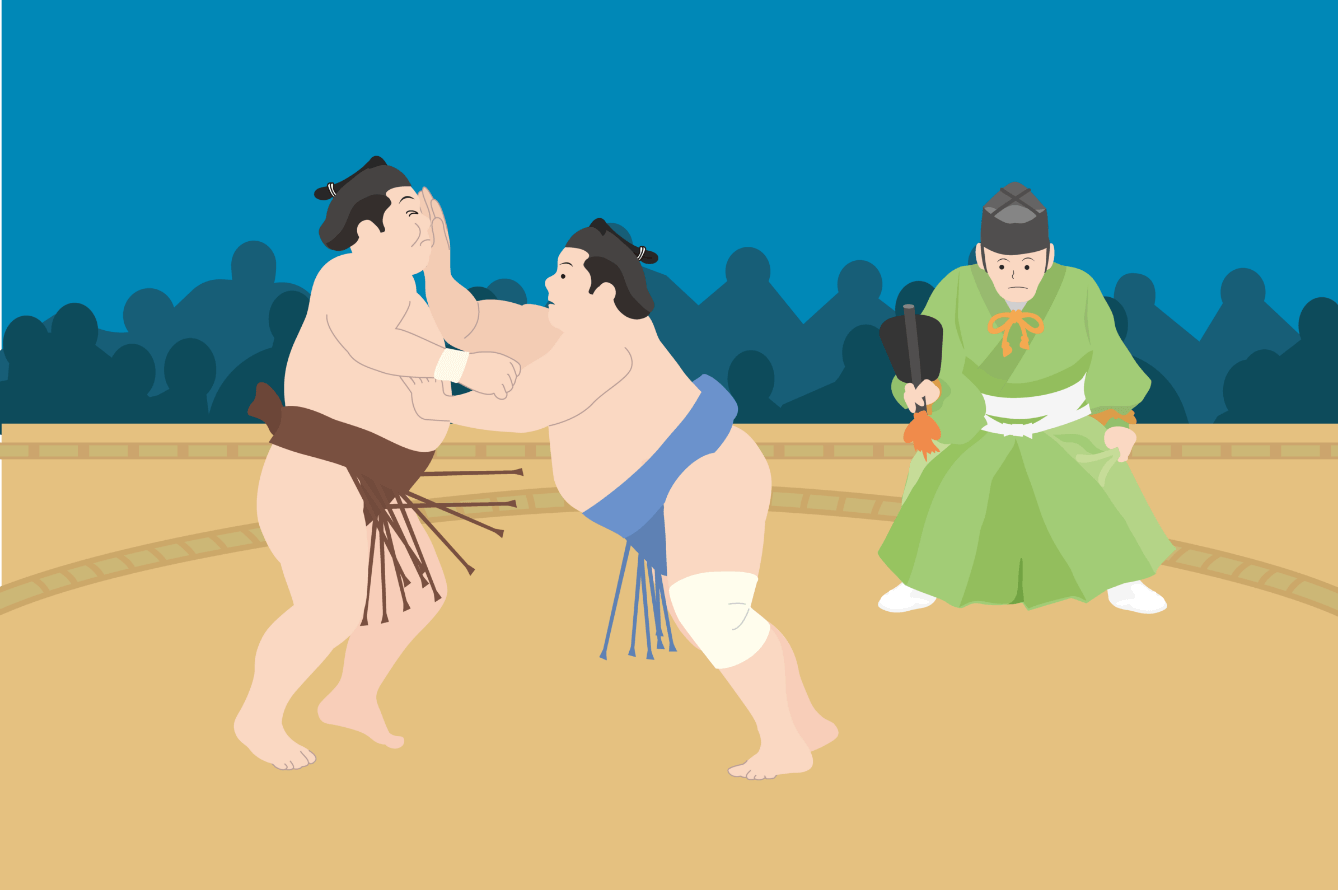
決まり手は、外国の相撲ファンの間ではYorikiriなどと、日本語のローマ字表記でいうケースが多く見られます。「Yorikiri, or forcing out」と、ローマ字表記にorをつけて意訳を添えると親切です。決まり手は全部で82ありますが、ここではよく出てくるものを紹介しています。
- 決まり手:winning trick /winning technique
- 寄切り:frontal force out /forcing out
- 押し出し:frontal push out /pushing out
- はたき込み:slap down /slapping down
- 引き落とし:hand pull down /pulling down
- 寄り倒し:frontal crush out
- つり出し:frontal lift out /lifting out
- 上手投げ:overarm throw
- 下手投げ:underarm throw
- 勇み足:forward step out /stepping out of the ring
成績や表彰制度に関する用語
- 白星(勝つこと):win /victory mark
- 黒星(負けること):defeat /defeat mark
- 金星(横綱に勝つこと):win made against Yokozuna
- 対戦成績:record
- 勝ち越し:have more wins than losses
- 負け越し:have more losses than wins
- 優勝:championship
- 天皇賜杯(幕内最高優勝をした力士に贈られる賜杯):Emperor’s cup /trophy given by the Emperor
三賞:three special awards
- 技能賞:technique award
- 敢闘賞:fighting-spirit award
- 殊勲賞:outstanding performance award
- 懸賞金:prize money
- 昇進:promotion
- 降格:demotion
相撲に関する会話表現
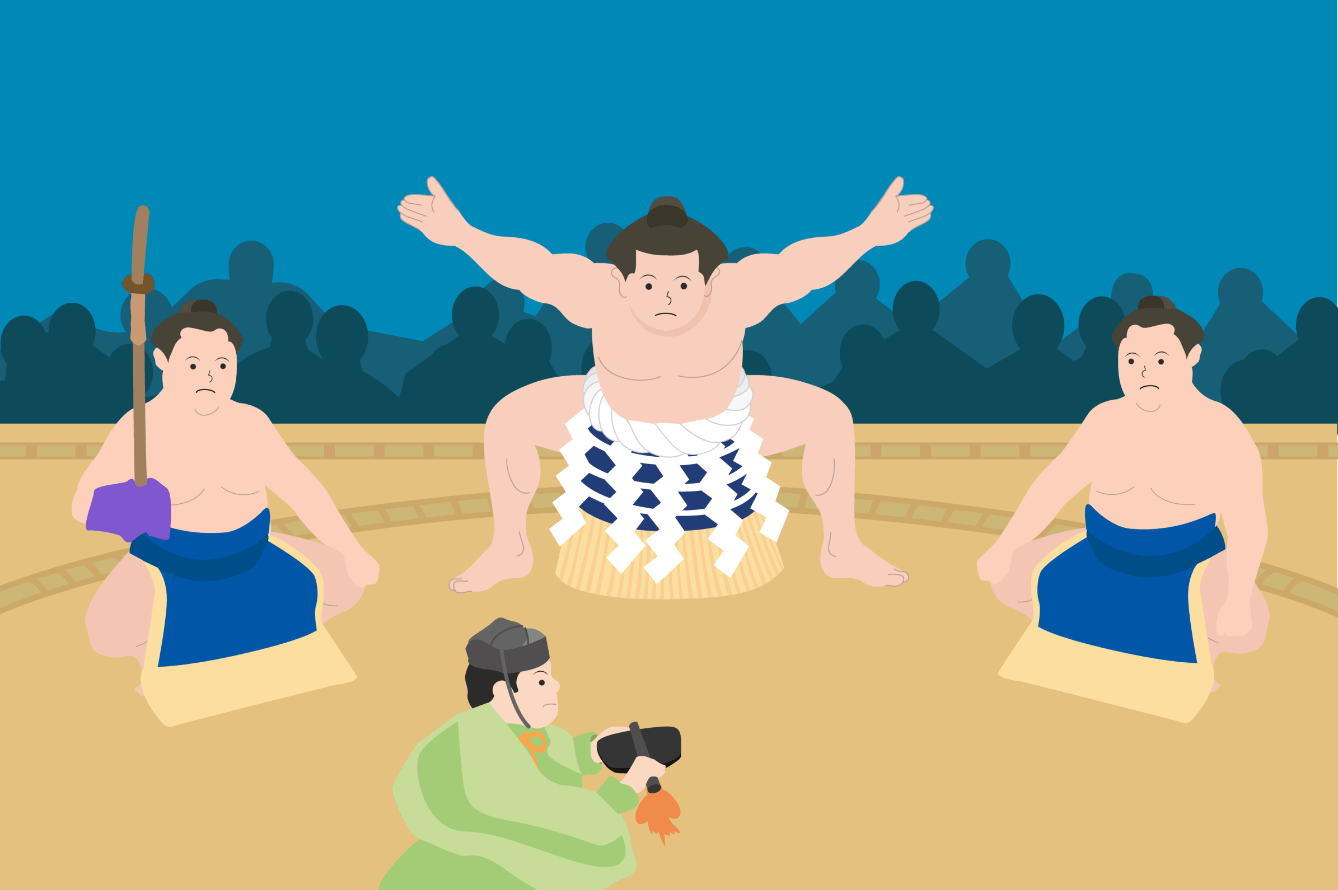
以下では、相撲を話題にするとき使える会話表現を挙げています。
相撲観戦に誘うための会話表現
- 相撲を見たことがありますか?:Have you ever seen sumo?
- 相撲観戦のためにご一緒に国技館へ行きませんか?:Would you like to go to the Kokugikan Sumo Arena for watching sumo with me?
- 興行時間はだいたい午前8時半から午後6時までです。:The playtime is from around 8:30 am to 6 pm.
- 取組は、低い番付の力士から高い番付の力士の順に設定されています。:The bouts are scheduled from the lower-ranked wrestlers to the higher ones.
- 食事やお茶を楽しみながら、一日を会場で過ごす人もいます。:Some people stay at the hall all day long, while enjoying a meal and tea.
- 多くの観客は、午後3時頃から会場入りします。そのくらいの時間から、強くて有名な力士の対戦が組まれているからです。:Many spectators enter the hall around 3 pm, because strong and famous wrestlers’ bouts are set from that time and afterwards.
- ほとんどの席では、アルコールも含めて飲食可能です。:Eating and drinking is accepted, including alcohol, in most of the seats.
- 相撲茶屋(相撲案内所)を通してチケットを取ることができます。:We can book the tickets through sumo teahouses.
- 相撲茶屋に割増料金を払うと、出方さん(客の案内役)が料理や飲み物を席まで届けてくれ、特別なお土産も付きます。:If you pay an extra fee to a sumo teahouse, a professional waiter will serve you a meal and a drink at your box seat and you also get some original sumo goods.
- チケットは、ネットやチケットショップでも買えます。:We can buy the tickets through the Internet or at a ticket shop.
- もし当日に切符売場でチケットを買うつもりなら、朝早く行かなければいけません。:If we are going to get the tickets at the ticket booth on the day, we will have to go there very early in the morning.
相撲について説明するための会話表現
- 相撲は日本の国技として知られています。:Sumo is known as the national sport in Japan.
- 相撲のルールはとても簡単です。:Sumo’s rules are very simple.
- 相手を土俵から出したり、体の足裏以外の箇所を土俵に触れさせたりしたら勝ちです。:A wrestler wins when he pushes the opponent out of the ring, or forces the opponent to touch the ground with any parts of the body except soles.
- 平手打ちは許容されていますが、こぶしで殴るのは駄目です。:Slapping is acceptable, but punching is not.
- まげを引っ張ったら、反則負けです。:It’s a foul and loss if a wrestler pulls the opponent’s topknot.
- 8世紀から12世紀にかけて、相撲は神々や上流階級の人々を楽しませるための宮廷儀式でした。:From the 8th century to the 12th century, sumo had been a court ritual to entertain the gods and the nobles.
- 相撲には、塩や水で清めの儀式を行うなど、神道に関わる宗教の要素が今日でも多く見られます。:Even today, we can recognize many religious elements related to Shinto in sumo, for instance, rituals for purification with salt and water.
- 江戸時代、相撲は庶民に人気のエンターテインメントとなりました。:In the Edo era, sumo became a popular form of entertainment among the common people.
- 力士や行司の外見は、江戸時代の特徴を残しています。:The appearance of wrestler and referee has the remaining characteristics of the Edo era.
1. orで訳す
(例)
(例文)対戦の前に、両力士は口を力水で清めます。:
2. ハイフンでつなぐ
(例)
(例文)彼は相手のまわしをつかんだ!:
おすすめ動画・サイト
Techniques: The September 2021 GRAND SUMO Tournament – GRAND SUMO
NHKの相撲中継は、午後4時頃から英語の実況がつきます。ネイティブ向けなので高難度ですが、さまざまな取組を解説しているので「日本語固有の表現を英語に言い換える」実例が豊富で勉強になります。この動画はその実況の、2021年九月場所の抜粋です。字幕なしなので上級者むけですが、初中級者でも繰り返し聞くとよいトレーニングになるでしょう。
Shodai [正代] – GRAND SUMO
ナレーションの速度はなかなか速いけれど、字幕がつくので初中級者におすすめです。このチャンネル内には他にも、力士個人にフィーチャーした動画があるので、ご贔屓を探してみてはいかがでしょうか。
The Techniques of Sumo
相撲の決まり手を英語で紹介しているサイトです。決まり手のローマ字表記とその英訳をチェックするのに好適です。各決まり手に、それを英語で解説する短い動画がついています。字幕はないので高難度ですが、繰り返し視聴するとよい勉強になるでしょう。
Sumo Wrestling 101 | National Geographic
相撲の概説動画です。字幕もなく、ネイティブ向け番組なので高難度です。しかし、相撲の知識が助けになるので、チャレンジしてみてはいかがでしょうか。
まとめ
相撲に関する英単語や英会話表現は、相撲特有の用語を英訳するので、ハードルが高いことでしょう。しかしこの記事で紹介した表現を使えば、基本的なことは表現できます。それ以上の高度な技や複雑な勝負については、「自分ならどう言い表すかな」と考えて、いろいろ練習してみてください。楽しみながら英語力もアップさせられますよ!

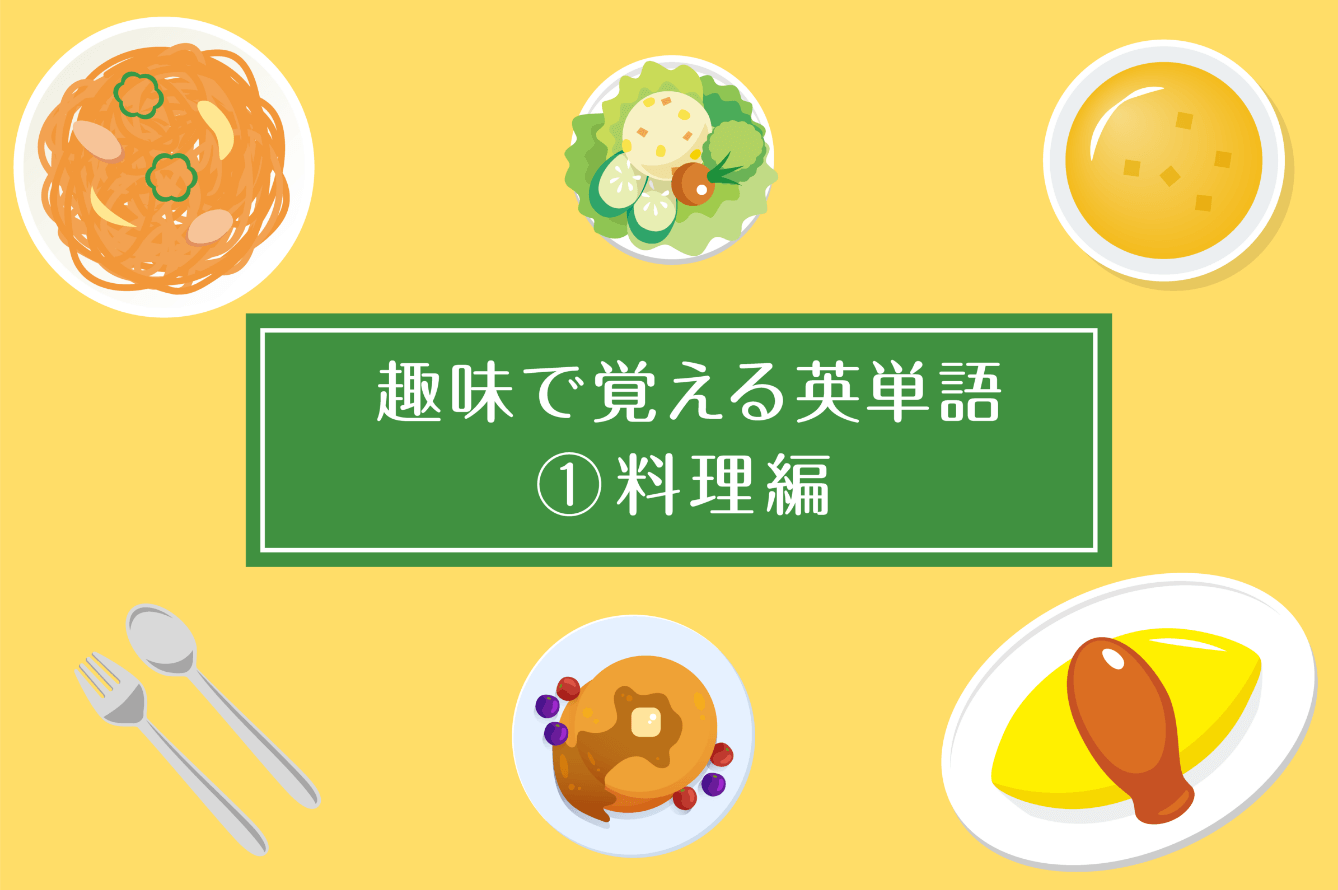
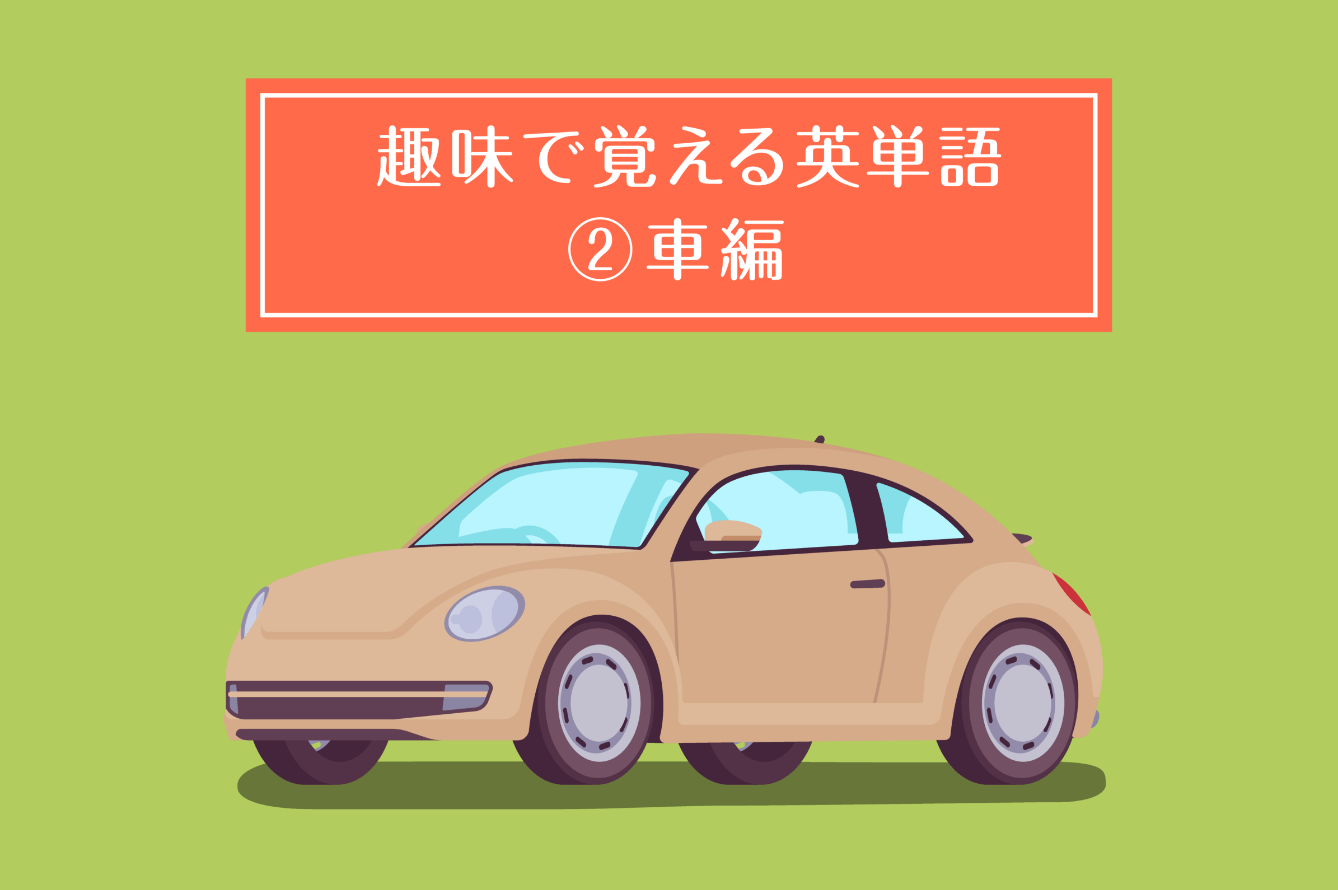
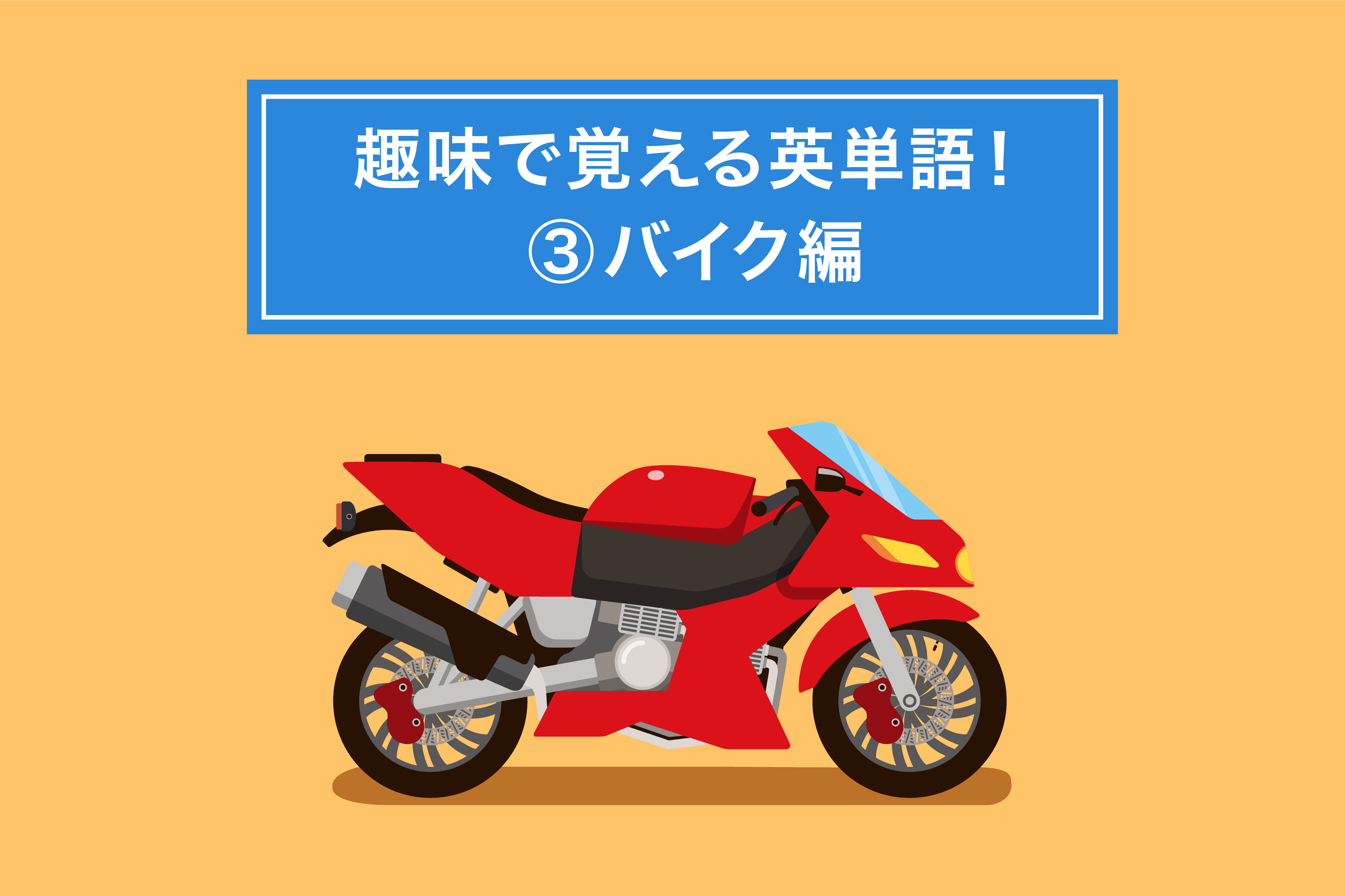
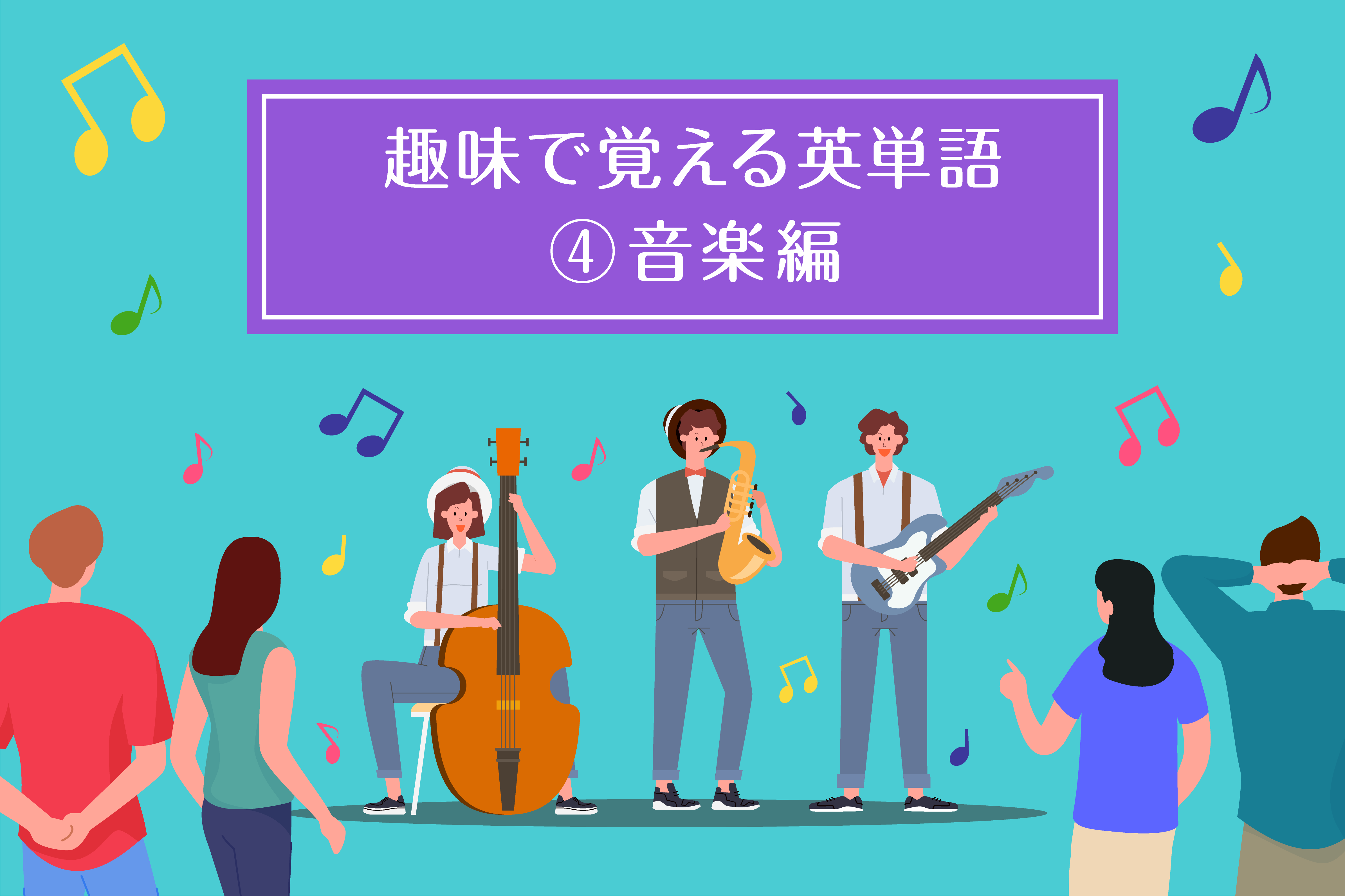

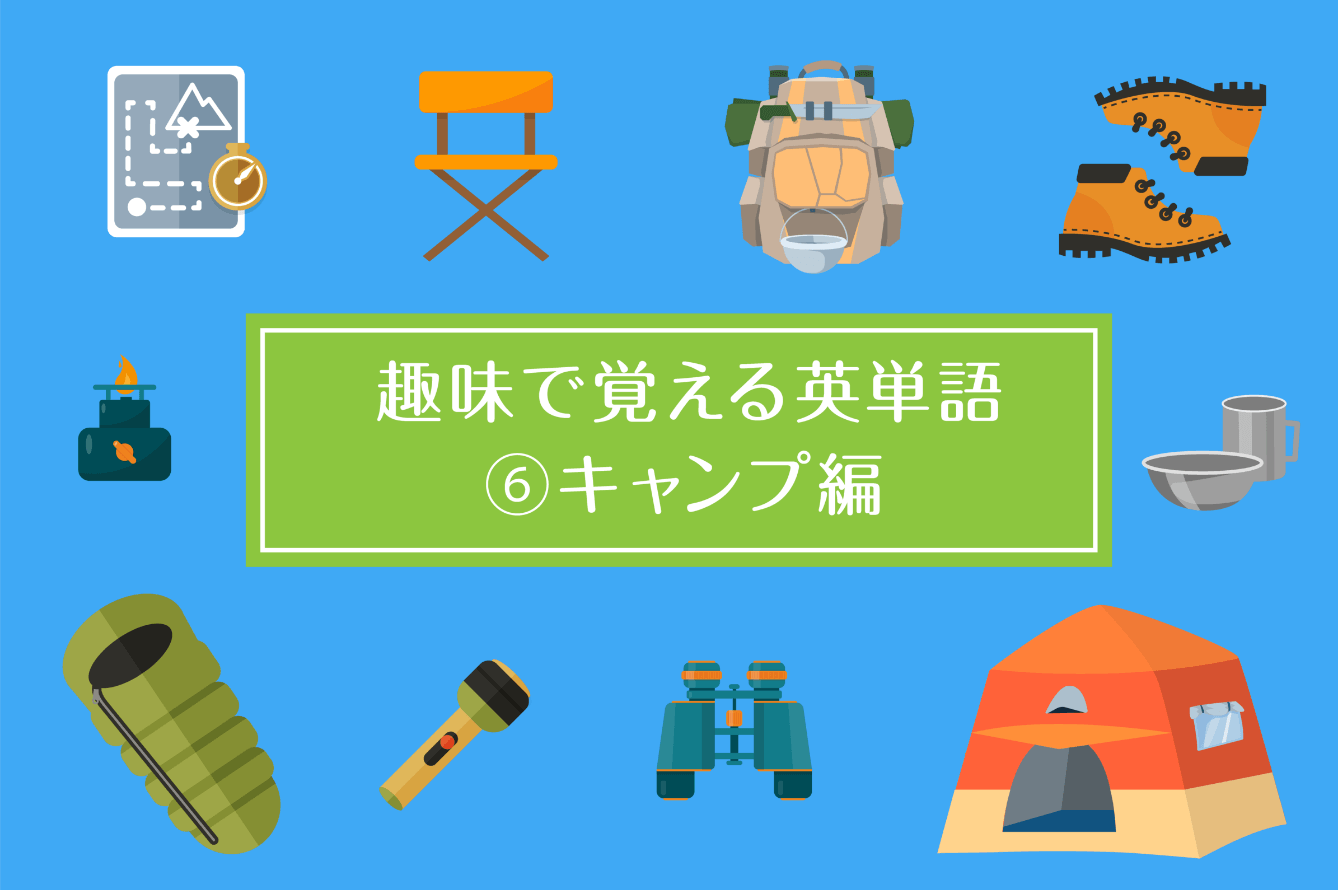


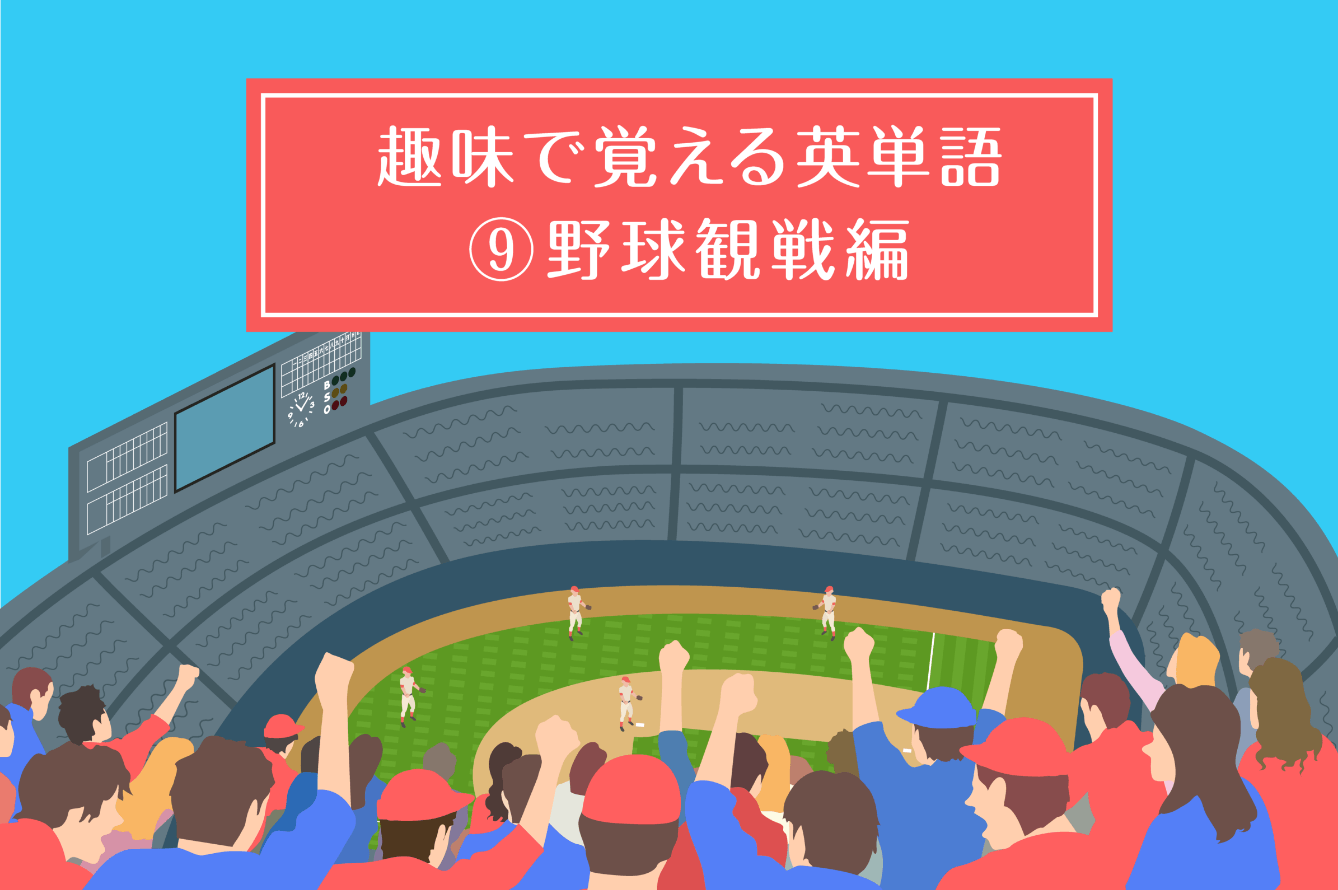






番付の「東」「西」は
(例)西十両10枚目:
東西の優劣(東の方が上位)を意識して、
(例)彼は東前頭4枚目です。:
東西という呼称について説明するには、以下のような例が挙げられます。
(例)同じ階級の2力士の間では、東の力士の方が階級が上です。彼は東前頭6枚目ですから、西前頭6枚目より上です。: